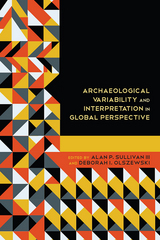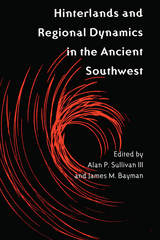2 books about Sullivan, Alan P.

Archaeological Variability and Interpretation in Global Perspective
Alan P. Sullivan
University Press of Colorado, 2016
In Archaeological Variability and Interpretation in Global Perspective, contributors illustrate the virtues of various ecological, experimental, statistical, typological, technological, and cognitive/social approaches for understanding the origins, formation histories, and inferential potential of a wide range of archaeological phenomena. As archaeologists worldwide create theoretically inspired and methodologically robust narratives of the cultural past, their research pivots on the principle that determining the origins and histories of archaeological phenomena is essential in understanding their relevance for a variety of anthropological problems.
The chapters explore how the analysis of artifact, assemblage, and site distributions at different spatial and temporal scales provides new insights into how mobility strategies affect lithic assemblage composition, what causes unstable interaction patterns in complex societies, and which factors promote a sense of “place” in landscapes of abandoned structures. In addition, several chapters illustrate how new theoretical approaches and innovative methods promote reinterpretations of the regional significance of historically important archaeological sites such as Myrtos-Pyrgos (Crete, Greece), Aztalan (Wisconsin, USA), Tabun Cave (Israel), and Casas Grandes (Chihuahua, Mexico).
The studies presented in Archaeological Variability and Interpretation in Global Perspective challenge orthodoxy, raise research-worthy controversies, and develop strong inferences about the diverse evolutionary pathways of humankind using theoretical perspectives that consider both new information and preexisting archaeological data.
Contributors: C. Michael Barton, Brian F. Byrd, Gerald Cadogan, Philip G. Chase, Harold L. Dibble, Matthew J. Douglass, Patricia C. Fanning, Lynne Goldstein, Simon J. Holdaway, Kathryn A. Kamp, Sam Lin, Emilia Oddo, Zeljko Rezek, Julien Riel-Salvatore, Gary O. Rollefson, Jeffrey Rosenthal, Barbara J. Roth, Sissel Schroeder, Justin I. Shiner, John C. Whittaker, David R. Wilcox
The chapters explore how the analysis of artifact, assemblage, and site distributions at different spatial and temporal scales provides new insights into how mobility strategies affect lithic assemblage composition, what causes unstable interaction patterns in complex societies, and which factors promote a sense of “place” in landscapes of abandoned structures. In addition, several chapters illustrate how new theoretical approaches and innovative methods promote reinterpretations of the regional significance of historically important archaeological sites such as Myrtos-Pyrgos (Crete, Greece), Aztalan (Wisconsin, USA), Tabun Cave (Israel), and Casas Grandes (Chihuahua, Mexico).
The studies presented in Archaeological Variability and Interpretation in Global Perspective challenge orthodoxy, raise research-worthy controversies, and develop strong inferences about the diverse evolutionary pathways of humankind using theoretical perspectives that consider both new information and preexisting archaeological data.
Contributors: C. Michael Barton, Brian F. Byrd, Gerald Cadogan, Philip G. Chase, Harold L. Dibble, Matthew J. Douglass, Patricia C. Fanning, Lynne Goldstein, Simon J. Holdaway, Kathryn A. Kamp, Sam Lin, Emilia Oddo, Zeljko Rezek, Julien Riel-Salvatore, Gary O. Rollefson, Jeffrey Rosenthal, Barbara J. Roth, Sissel Schroeder, Justin I. Shiner, John C. Whittaker, David R. Wilcox
[more]

Hinterlands and Regional Dynamics in the Ancient Southwest
Alan P. Sullivan
University of Arizona Press, 2007
Hinterlands and Regional Dynamics in the Ancient Southwest is the first volume dedicated to understanding the nature of and changes in regional social autonomy, political hegemony, and organizational complexity across the entire prehistoric American Southwest. With geographic coverage extending from the Great Plains to the Colorado River, and from Mesa Verde to the international border, the volume’s ten case studies synthesize research that enhances our understanding of the ancient Southwest’s highly variable demographic, land use, and economic histories. For this volume, “hinterlands” are those areas whose archaeological records do not disclose the ceramic, architectural, and network evidence that initially led to the establishment of the Hohokam, Chaco, and Casas Grandes regional systems. Employing a variety of perspectives, such as the cultural landscapes approach, heterarchy, and the common-pool resource model, as well as technical methods, such as petrographic and stylistic-attribute analyses, the volume’s contributors explore variation in hinterland identities, subsistence ecology, and sociopolitical organization as regional systems expanded and contracted between the 9th and 14th centuries AD. The hinterlands of the prehistoric Southwest were home to a substantial number of people and were often used as resource catchments by the inhabitants of regional systems. Importantly, hinterlands also influenced developments of nearby regional systems, under whose footprint they managed to retain considerable autonomy. By considering the dynamics between hinterlands and regional systems, the volume reveals unappreciated aspects of the ancient Southwest’s peoples and their lives, thereby deepening our awareness of the region’s rich and complicated cultural past.
[more]
READERS
Browse our collection.
PUBLISHERS
See BiblioVault's publisher services.
STUDENT SERVICES
Files for college accessibility offices.
UChicago Accessibility Resources
home | accessibility | search | about | contact us
BiblioVault ® 2001 - 2025
The University of Chicago Press









